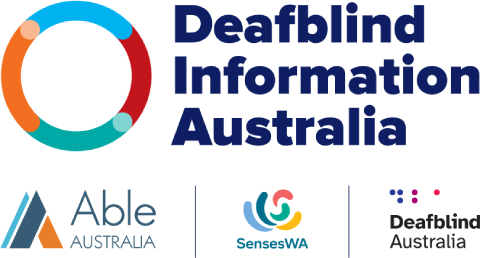A life with deafblindness can be meaningful and filled with opportunities to experience and engage with the world, such as
- adapting the environment and communication methods,
- utilising technology, and
- exploring methods to move from place to place safely.
Circumstances and experience of deafblindness will be different for each individual. The impact on a person’s life and that of their family, carers, and others will be also differ.
A person who is born deaf or hard of hearing and later their vision starts to deteriorate:
- A person who is born hard of hearing may, or may not, wear a hearing aid depending on the level and type of hearing loss. Speech may be the primary method of communication. However, many people use lip reading because they miss a percentage of conversations through speech alone.
- A person who is born Deaf may learn to communicate visually through the use of sign language. Australian Sign Language (Auslan) is a language in its own right being the first language used by people in the Deaf Community.
- A person with a hereditary condition such as Usher Syndrome may start to experience gradual sight loss in their teens or early 20’s through Retinitis Pigmentosa (RP). This means going through frequent periods in their lives where they need to re-adjust to this progressive eye disease.
A person who is born blind or vision impaired and later their hearing starts to deteriorate:
- A person who was born blind or vision impaired will have learned to use their hearing to compensate. For example, using their listening skills in conversations or using talking books. Advances in technology over the last 20 years have increased options with speech reading software on computers and other equipment.
- A person who is blind or vision impaired may have been taught orientation and mobility (O&M) skills using a cane or a guide dog. O&M teaches people to make best use of their hearing to identify auditory cues when out and about.
- People who have residual vision may have learned skills to make best use of their vision to be independent in everyday life.
A person who is born with vision and hearing and later both senses start to deteriorate (not necessarily at the same time):
- Accident, injury, disease or the ageing process may cause a person to lose some or all of both vision and hearing senses.
The degree of functional vision and/or hearing that a person has will vary, as will the degree and rate of deterioration of the sense(s).
A person may compensate with their vision as hearing deteriorates and vice versa. As the “better” sense also starts to deteriorate the person may face challenges in adjusting to life with dual sensory loss. A person may experience difficulties with communication, everyday tasks in the home, finding out information and getting out and about safely and confidently.
Consider how a person who is Deaf or hard of hearing uses their vision or reduced levels of hearing to communicate. It is likely there will be a significant impact on their ability to communicate as their vision deteriorates.
For a person who has relied on hearing throughout their life, losing some or all of their hearing will impact significantly. The way that they communicate and use auditory cues to negotiate their environment are some areas of their life that will change.
The majority of people will have some vision and/or hearing and can learn, with the right support, to adapt and regain independence skills.
Some people will also have other health or physical conditions. This will increase the impact that the dual sensory loss has on their life and the lives of those living around them.
This booklet includes tips for how to support people with vision and hearing loss in overcoming everyday practical difficulties.
Open PDF ‘You and Me Keeping in Touch’ in a new tab
Communicating can become difficult for people who are experiencing deteriorating vision and hearing. This booklet has tips on more effective communication and support, and reducing isolation caused by dual sensory loss.


